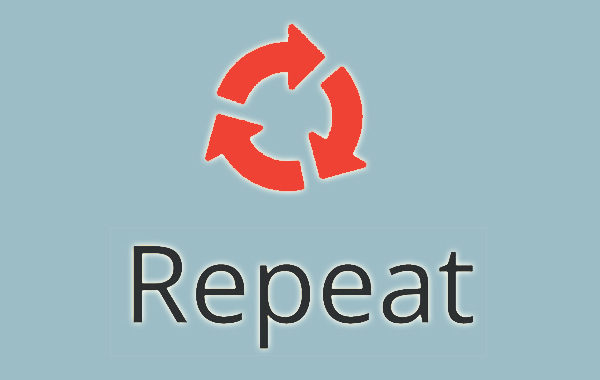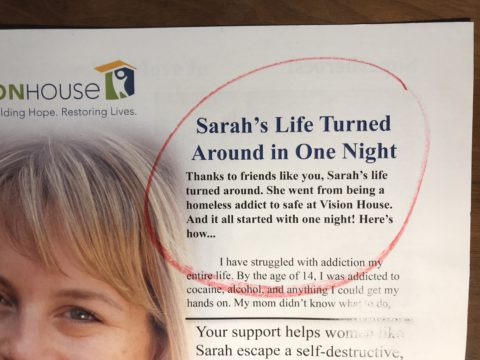The following is a hand-picked guest post from Lisa Sargent. Enjoy, and you can read more about Lisa below.
* * *
My job is fundraising copywriting.
So if people don’t read the direct mail appeals I write, you better believe I know it. Revenue, response, retention, those things are going to go down.
Which means I also know – firsthand – that when someone tells you, “No one reads long letters anymore” – it’s rubbish.
But we’re not here to be combative.
Instead, I want you to think about your letters like a working fundraising writer.
So today we’re going to take that “No long letters ever” myth (because it IS a myth) and run with it…
Let’s assume you one day decide your fundraising appeals will not… must NEVER… exceed 1 sheet of paper. (DO NOT decree this in real-life please. It’s a huge mistake. Keep reading.)
Let’s also assume you want to format your letter for maximum readability (readability boosts response fyi). This means:
- You need 1-1.5” for your nonprofit logo/letterhead
- You want 1” margins left and right
- You want ~1” for bottom page margin
- You need type size set at 12-14 points, in a font that isn’t condensed
- You need to tab (indent) your paragraphs
- You need 1-2 lines for a page turn reminder (e.g., ‘continues on other side’; watch my YouTube video w/ John Lepp on this)
- You need 1-1.5” for your signature block and side 2 sign-off
- You may (or may not) need an add’l .5 -.75” for footer with your charity number, tax ID, disclaimer, etc.
- You may (or may not) need a 2” address block.
I am NOT saying you can’t successfully write short. You can. I have. Lots of others, too.
What I AM saying is that after the above, you have about 750 words to get the job done.
Add a paragraph on both sides to ask for a gift, and you’re at, what, 650 words?
In the wrong hands these letters get real boilerplate, real quick. In real-life, this works so much better:
Make your fundraising appeals as long as they need to be to:
- Tell your story with emotion, clarity, resonance, truth, and urgency, present a strong offer, and provide repeated calls to action.
- Format for readability.
- If you use photos (Designer Sandie and I often do), you also need space for photo captions.
From nearly two decades of measured results like conversions, click-throughs, average gifts, and response rates, I can tell you this:
Many of my best-performing appeals are 6-page letters. (Yup. Recently, too.) Many others are 4-page letters.
Several of these include multi-year control packs (a.k.a. banker’s packs, that have yet to be surpassed in terms of results and response).
Some are 2-pagers. None are postcards. And again, all of this is based on actual results.
Top emails? 450 to 750+ words. (More on that in a minute.)
So if your team is agonizing over short letter vs. long, have them focus instead on what no one really wants:

Credit: Photo (c) Lisa Sargent, Thankology [design: S. Collette]
No one wants a 4-page letter crammed onto 1-page/2-sides;
No one wants 8-point type with yawning wide line measures that skyrocket eye fatigue and create an Impenetrable Wall of Text (what do I mean? see above);
No supporter wants boilerplate EVER. They want emotion, a strong offer, life, authenticity, connection, urgency, love.
Write the above into all your creative briefs before you mandate letter length, and watch your fundraising appeals improve.
For your emails?
You can absolutely write longer (as in 450-750 words). But remember to keep it top-heavy:
- You have 1-2 lines to get to the point.
- Make your first call to action (i.e., Ask) within 140 words. (My best-performing emails do this in the first 90 words or so.)
- Front-load your subject line (best parts first)
- Below first call to action you can expand your story, and add repeated calls to action after that
- Check out NextAfter’s research around plain-text emails (and, really, their entire Digital Research Library: great for experimenting with format)
Now here’s one last tip, exclusively for Better Fundraising Co. blog readers (that’s you!)… just to really shake things up… one last letter that should really be just one page long.
Meet the one letter that’s really one page: Your donation thank-you letter.
In my book Thankology (on Amazon or Bookshop) there’s an entire chapter called “Clear thinking on the format fog: The core pieces your thank-you pack needs.”
The nutshell version is this:
Almost all the time, your donation thank-you letter should be a 1-page, 1-sided letter, specific to the appeal or newsletter or occasion that prompted it.
Why? Two reasons.
First, because you want the whole, wonderful thing to be visible when your reader opens the letter. Your longer appeal letter, remember, did the long-as-it-needs-to be job.
THIS letter, your thank-you letter, gets the short and sweet spotlight: All the love and gratitude magic right there on one page.
Second, because if it’s longer, you run the risk of it looking like an appeal. Want to add a photo? Why not pop in a little photo card? (Added benefit: your supporter has a mantle-worthy keepsake to remind them of their connection to your cause, and your lovely thank-you.)
Remember: Appeal letters are longer. Thank-you letters, almost always, are not.
Now the next time someone tells you, “Your letter always has to be one page or else,” you have a smarter, results-based way to look at things.
Go forth and write that appeal with great heart… as long as it needs to be!
* * *
Steven says: Lisa Sargent is a fundraising expert and the author of Thankology, the best book on thanking donors that I’ve ever read. You can (and should!) subscribe to her newsletter here.
Did this post on letter length help you? If yes, you can:
- Subscribe to Lisa’s Loyalty Letter newsletter for fundraisers
- Connect/follow/say hello to Lisa on LinkedIn
- Check out Thankology (on Amazon or Bookshop)
- Find free fundraising resources at lisasargent.com
- Read more Loyalty Letters on Lisa’s Newsletter Hub
Thank you for reading today, and big thanks to Steven, Jim, and The Better Fundraising Co. for sharing a place on their blog. J
© Lisa Sargent and Lisa Sargent Communications, used with permission. If you adapt or repurpose this content in any format, please be a guardian of good karma and get your proper permissions. And, of course, remember that this information is provided for informational purposes only, and should not be considered as legal advice on any subject matter.













